Distributed Optical Fiber Sensing Bonding Techniques Performance for Embedment inside Reinforced Concrete Structures
Abstract
:1. Introduction
2. Literature Review
- The friction between DOFS and the surrounding concrete is the main reason for the appearance of SRAs. Therefore, the bonding techniques that seems to best insulates the former from the latter seem to yield to the most SRA-free outputs.
- Bonding adhesives aside, three main DOFS/rebar bonding techniques have been adopted up to now:
- ○
- Simply gluing the DOFS on the rebar’s surface away from the transversal ribs;
- ○
- Gluing the DOFS to the rebar’s surface and covering it with a silicone-based protection layer;
- ○
- Incising a groove on the rebar’s surface and positioning the DOFS inside it before gluing it;
- The presence of silicone and of a groove seems to improve the quality of the DOFS extracted profiles;
- Despite such improvement, none of these techniques seems to unequivocally guarantee the absence of SRAs;
- A combination of groove and silicone has not been tested yet.
3. Experimental Setup
3.1. RC Specimen Description
- DOFS positioned inside a groove and bonded with cyanoacrylate (CYN) as visible in Figure 5a;
- DOFS glued to the rebar’s surface with CYN with a protective layer of silicone (SI) on top, as visible in Figure 5b;
- DOFS positioned inside a groove, bonded with CYN and further covered with SI. As visible in Figure 5c.
3.2. The Experimental Campaign: The Concept and Its Phases
4. Test Results
4.1. Phase 1: Bare Rebar Testing in Tension and Bending
4.2. Phase 2: RC Ties Testing
4.2.1. Non-Cracking RC Ties
4.2.2. Cracking RC Ties
- A preparatory study of the rebars’ minute bending (could be achieved through 3D scanning technique for example) and the bonding of the DOFS strictly in those areas where the straightening of rebar will cause compression;
- Use of a different protective agent than SI;
- Application of a thicker layer of SI than the one applied to further insulate the DOFS.
5. SRA Analysis per Every DOFS/Rebar Bonding Technique
6. Conclusions
- The presence of a longitudinally incised groove and silicone (SI) as extra protection for the DOFS against external factors is un-influential on bare rebars subjected to pure tension or bending;
- The combination of a groove, cyanoacrylate (CYN) and SI is the bonding technique that leads to the smallest increase of noise magnitude of the DOFS profiles with increasing load;
- None of the studied bonding techniques could completely guarantee the removal of all SRAs. Yet, the combination of a longitudinally incised groove, CYN and SI is the bonding technique that leads to the smallest amount of strain reading anomalies (SRAs) thus preserving the readability and reliability of the strain data;
- An unexpected phenomenon, possibly connected to the under-performance of the above bonding technique, causes an alteration of the DOFS strain readings whenever the fiber is in the presence of extra bending-induced tension (smoothened strain profiles as in Figure 16, Face A) and/or monitoring strains in cracked cross-sections (magnifying their amount as in Figure 18);
- Despite its superior performance compared with other bonding techniques, the combination of groove, CYN and SI suffers gravely of the above issue and thus cannot be referred to as an ideal DOFS/rebar bonding technique but simply as the most performant among the modern-day ones;
- Further research is then required on substituting SI with an equally protective adhesive that does not transfer any internal extra stretches to the DOFS, allowing it to sample strictly the rebar’s strains. Furthermore, the bonding performances should be studied with different testing conditions such as dynamic (cyclic) and impact testing.
Author Contributions
Funding
Conflicts of Interest
References
- Bona, G.D.; Forcina, A.; Falcone, D.; Silvestri, L. Critical Risks Method (CRM): A New Safety Allocation Approach for a Critical Infrastructure. Sustainability 2020, 12, 4949. [Google Scholar] [CrossRef]
- Olawale, D.O.; Kliewer, K.; Okoye, A.; Dickens, T.J.; Uddin, J.; Okoli, O.I. Real time failure detection in unreinforced cementitious composites with triboluminescent sensor. J. Lumin. 2014, 147, 235–241. [Google Scholar] [CrossRef]
- Barrias, A.; Casas, J.R.; Villalba, S. A Review of Distributed Optical Fiber Sensors for Civil Engineering Applications. Sensors 2016, 16, 748. [Google Scholar] [CrossRef] [PubMed] [Green Version]
- Sieńko, R.; Zych, M.; Bednarski, Ł.; Howiacki, T. Strain and crack analysis within concrete members using distributed fibre optic sensors. Struct. Heal. Monit. 2018. [Google Scholar] [CrossRef]
- Luna Innovations Incorporated ODiSI 6000—Optical Distributed Sensor Interrogators. Available online: https://lunainc.com/wp-content/uploads/2017/11/LUNA-ODiSI-6000-Data-Sheet.pdf (accessed on 24 August 2020).
- Bao, X.; Chen, L. Recent Progress in Distributed Fiber Optic Sensors. Sensors 2012, 12, 8601–8639. [Google Scholar] [CrossRef] [PubMed] [Green Version]
- Rodríguez, G.; Casas, J.R.; Villaba, S. Cracking assessment in concrete structures by distributed optical fi ber. Smart Mater. Struct. 2015, 24, 35005. [Google Scholar] [CrossRef] [Green Version]
- Barrias, A.; Casas, J.R.; Villalba, S. Embedded Distributed Optical Fiber Sensors in Reinforced Concrete Structures. Sensors 2018, 18, 980. [Google Scholar] [CrossRef] [Green Version]
- Barrias, A.; Casas, J.R.; Villalba, S. Application study of embedded Rayleigh based Distributed Optical Fiber Sensors in concrete beams. Procedia Eng. 2017, 199, 2014–2019. [Google Scholar] [CrossRef] [Green Version]
- Davis, M.; Hoult, N.A.; Scott, A. Distributed strain sensing to determine the impact of corrosion on bond performance in reinforced concrete. Constr. Build. Mater. 2016, 114, 481–491. [Google Scholar] [CrossRef]
- Bado, M.F.; Casas, J.R.; Barrias, A. Performance of rayleigh-based distributed optical fiber sensors bonded to reinforcing bars in bending. Sensors 2018, 18, 3125. [Google Scholar] [CrossRef] [Green Version]
- Ansari, F.; Libo, Y. Mechanics of Bond and Interface Shear Transfer in Optical Fiber Sensors. J. Eng. Mech. 1998, 124, 385–394. [Google Scholar] [CrossRef]
- Wan, K.T.; Leung, C.K.Y.; Olson, N.G. Investigation of the strain transfer for surface-attached optical fiber strain sensors. Smart Mater. Struct. 2008, 17. [Google Scholar] [CrossRef]
- Henault, J.M.; Salin, J.; Moreau, G.; Quiertant, M.; Taillade, F. Analysis of the strain transfer mechanism between a truly distributed optical fiber sensor and the surrounding medium. In Proceedings of the Concrete Repair, Rehabilitation and Retrofitting III, Cape Town, South Africa, 3–5 September 2012; pp. 733–739. [Google Scholar]
- Bassil, A.; Chapeleau, X.; Leduc, D.; Abraham, O. Concrete Crack Monitoring Using a Novel Strain Transfer Model for Distributed Fiber Optics Sensors. Sensors 2020, 20, 2220. [Google Scholar] [CrossRef] [PubMed] [Green Version]
- Barrias, A.; Casas, J.R.; Villalba, S. Distributed optical fibre sensors in concrete structures: Performance of bonding adhesives and influence of spatial resolution. Struct. Control Heal. Monit. 2019, 26, 1–16. [Google Scholar] [CrossRef]
- Bado, M.F.; Casas, J.R.; Gomez, J. Post-processing algorithms for distributed optical fiber sensing in structural health monitoring applications. Struct. Heal. Monit. 2020. [Google Scholar] [CrossRef]
- Davis, M.; Hoult, N.A.; Scott, A. Distributed strain sensing to assess corroded RC beams. Eng. Struct. 2017, 140, 473–482. [Google Scholar] [CrossRef]
- Regier, R.; Hoult, N.A. Concrete deterioration detection using distributed sensors. Struct. Build. 2015, 168, 118–126. [Google Scholar] [CrossRef]
- Malek, A.; Scott, A.; Pampanin, S.; Hoult, N.A. Postyield Bond Deterioration and Damage Assessment of RC Beams Using Distributed Fiber-Optic Strain Sensing System. J. Struct. Eng. 2019, 145, 1–17. [Google Scholar] [CrossRef]
- Nurmi, S.; Mauti, G.; Hoult, N.A. Distributed Sensing to Assess the Impact of Support Conditionson Slab Behavior. In Proceedings of the 39th IABSE Symposium-Engineering the Future, Vancouver, ON, Canada, 21–23 September 2017; pp. 1478–1485. [Google Scholar]
- Brault, A.; Hoult, N. Distributed Reinforcement Strains: Measurement and Application. ACI Struct. J. 2019, 116, 115–127. [Google Scholar] [CrossRef]
- Berrocal, C.G.; Fernandez, I.; Rempling, R. Crack monitoring in reinforced concrete beams by distributed optical fiber Crack monitoring in reinforced concrete beams by distributed optical fiber sensors. Struct. Infrastruct. Eng. 2020, 0, 1–16. [Google Scholar] [CrossRef] [Green Version]
- Quiertant, M.; Baby, F.; Khadour, A.; Marchand, P.; Toutlemonde, F.; Rivillon, P. Deformation monitoring of reinforcement bars with a distributed fiber optic sensor for the SHM of reinforced concrete structure. Instrum. Mes. Metrol. 2013, 13, 131–147. [Google Scholar] [CrossRef]
- Michou, A.; Hilaire, A.; Benboudjema, F.; Nahas, G.; Wyniecki, P.; Berthaud, Y. Reinforcement-concrete bond behavior: Experimentation in drying conditions and meso-scale modeling. Eng. Struct. 2015, 101, 570–582. [Google Scholar] [CrossRef]
- Haefliger, S.; Mata-Falcon, J.; Kaufmann, W. Application of distributed optical measurements to structural concrete experiments. In Proceedings of the SMAR 2017–Fourth Conference on Smart Monitoring, Assessment and Regabilitation of Civil Structures, Zürich, Switzerland, 13–15 September 2017. [Google Scholar]
- Bado, M.F.; Kaklauskas, G.; Casas, J.R. Performance of Distributed Optical Fiber Sensors (DOFS) and Digital Image Correlation (DIC) in the monitoring of RC structures. In Proceedings of the IOP Conference Series: Materials Science and Engineering; IOP Publisher: New York, NY, USA, 2019; Volume 615. [Google Scholar]
- Bassil, A.; Wang, X.; Chapeleau, X.; Niederleithinger, E.; Abraham, O.; Leduc, D. Distributed fiber optics sensing and coda wave interferometry techniques for damage monitoring in concrete structures. Sensors 2019, 19, 356. [Google Scholar] [CrossRef] [PubMed] [Green Version]
- Bado, M.F.; Casas, J.R.; Kaklauskas, G. Distributed Sensing (DOFS) in Reinforced Concrete members for reinforcement strain monitoring, crack detection and bond-slip calculation. Eng. Struct. 2020, in press. [Google Scholar]
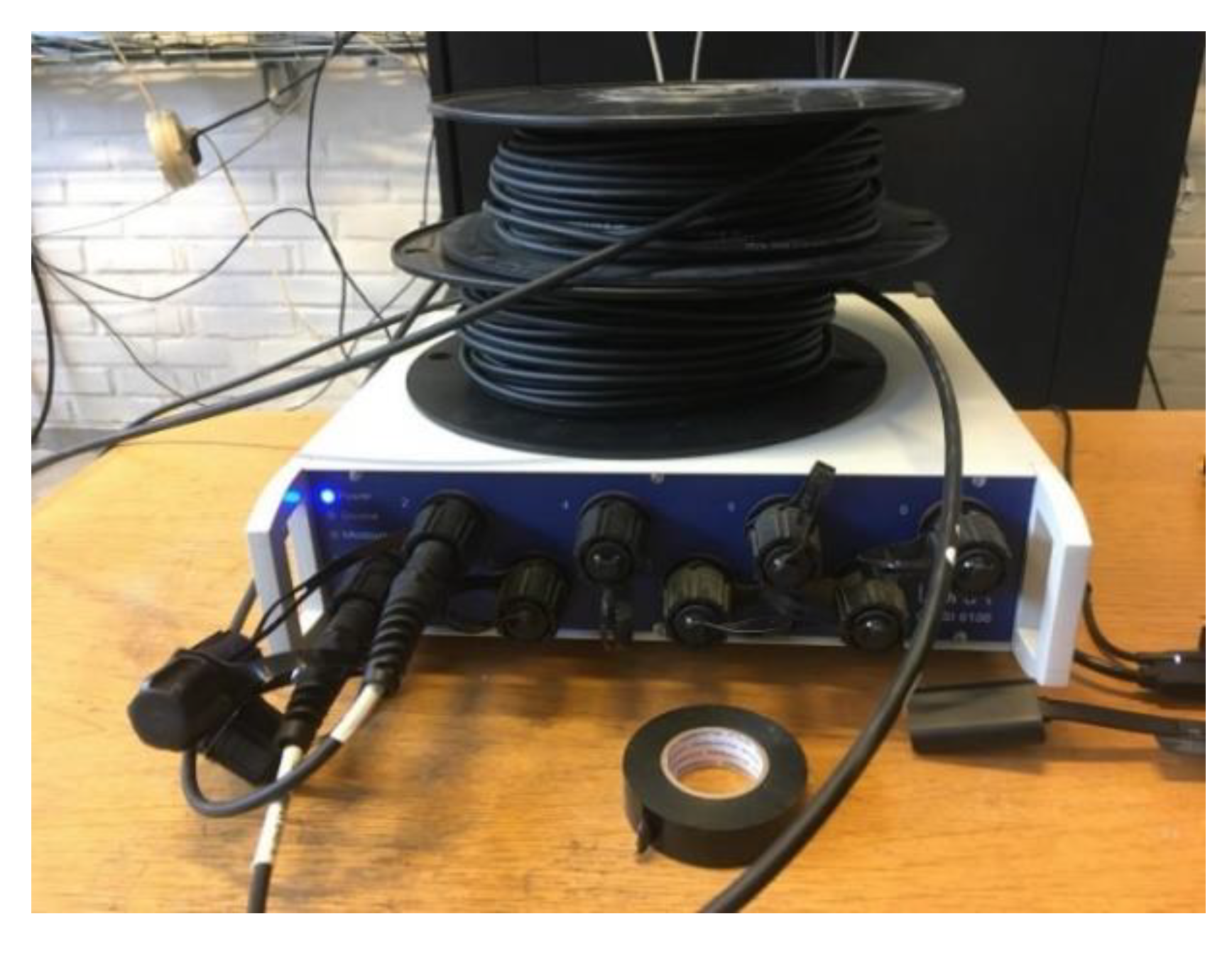
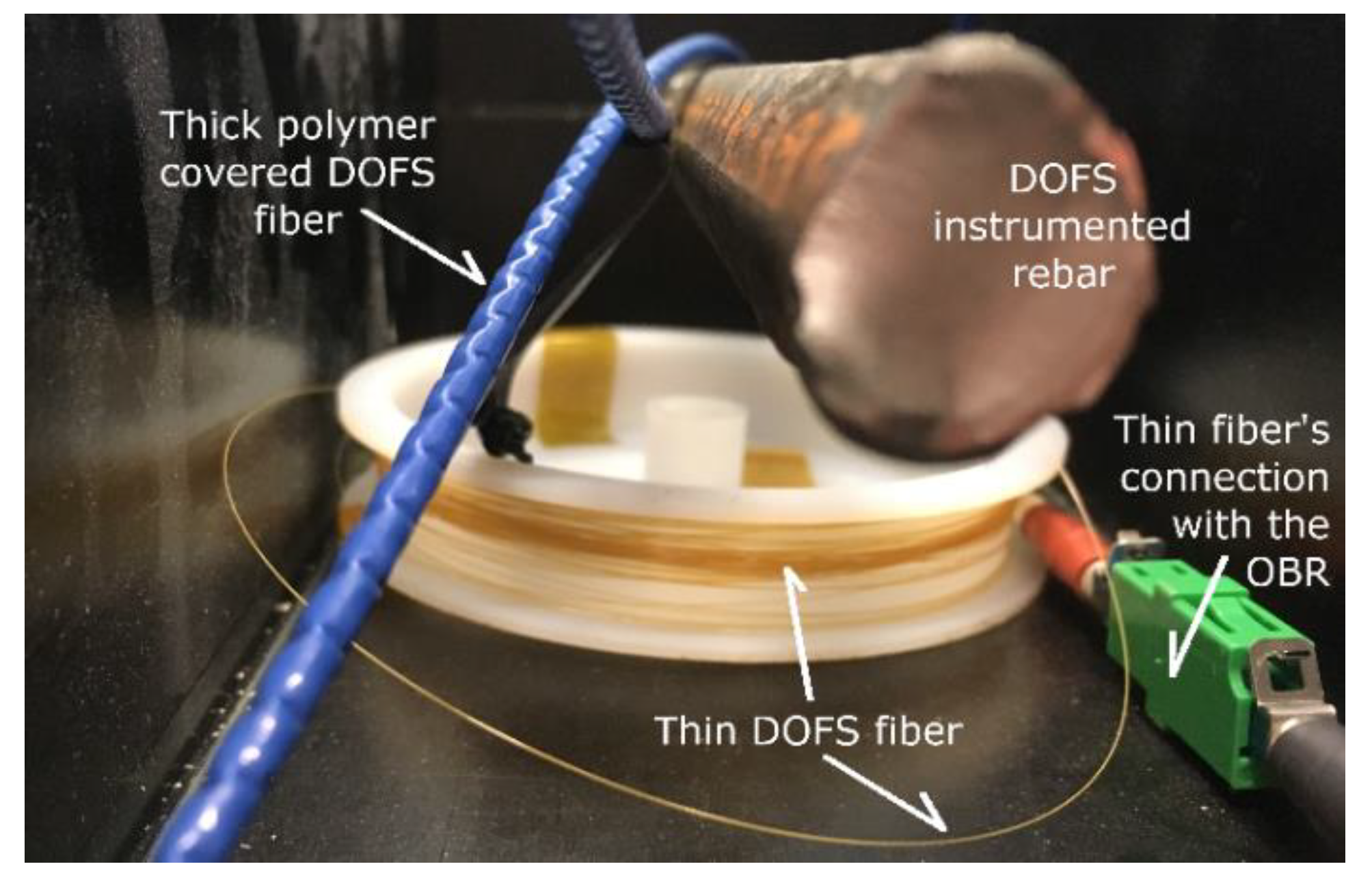
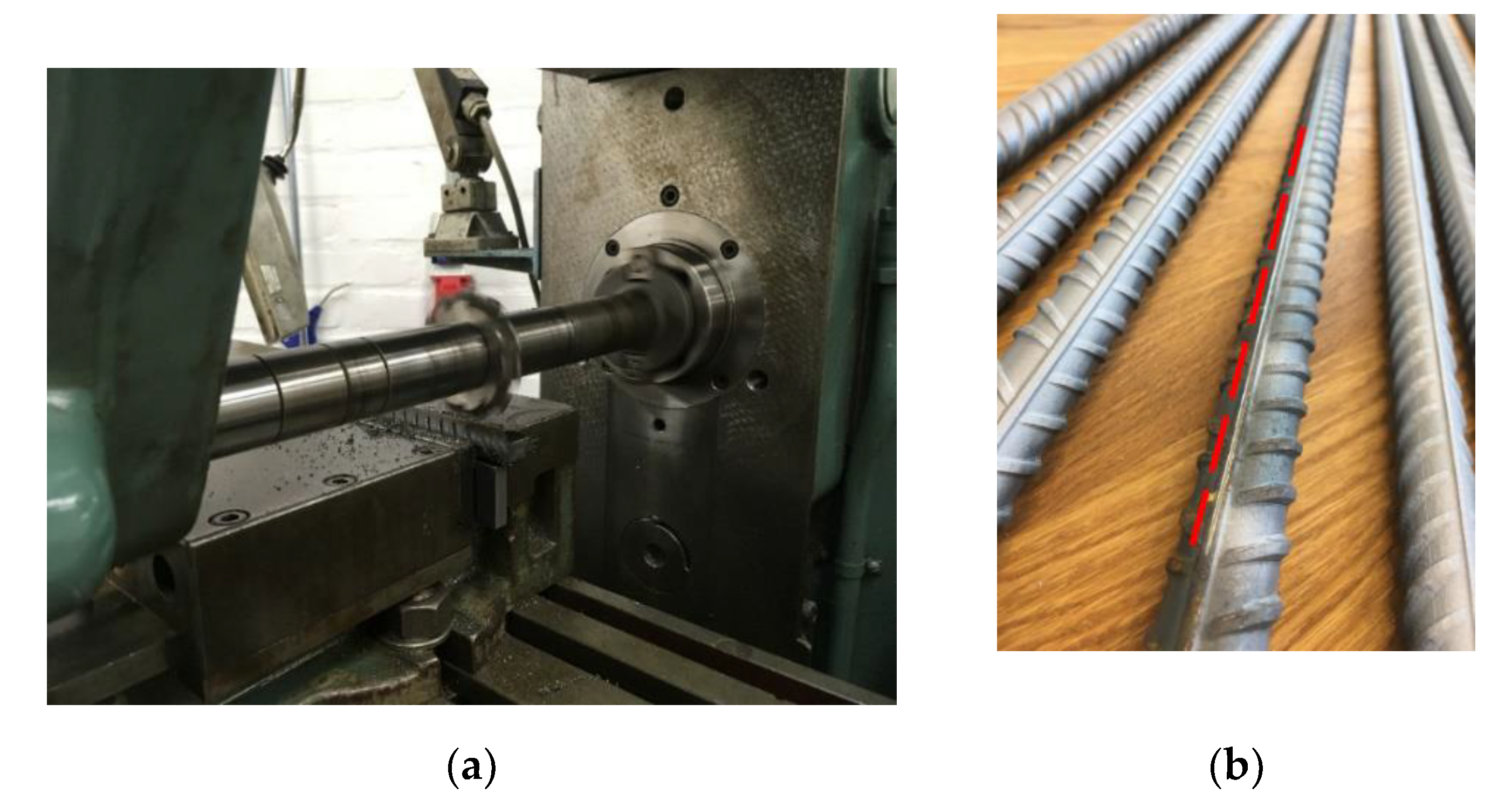
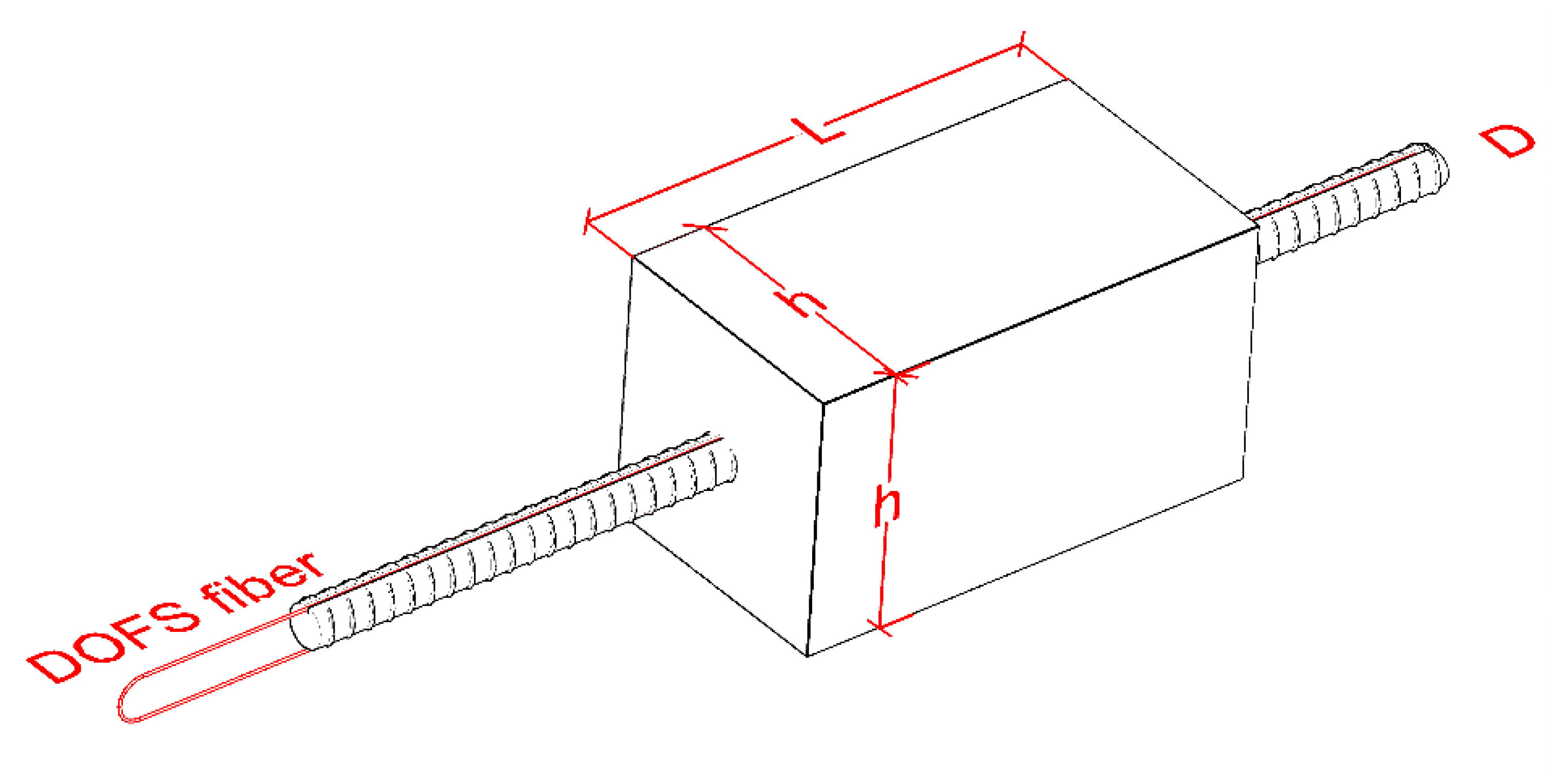
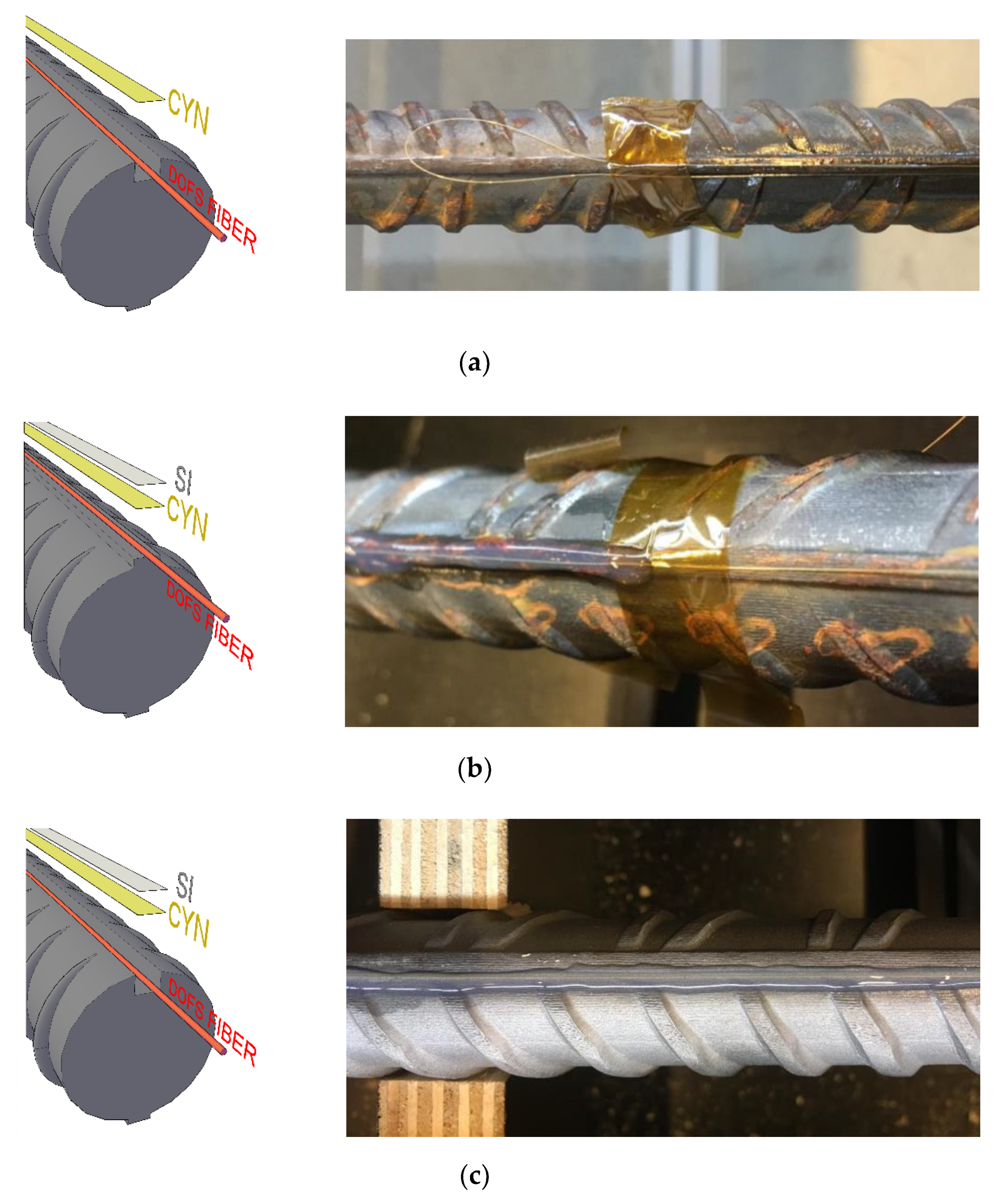
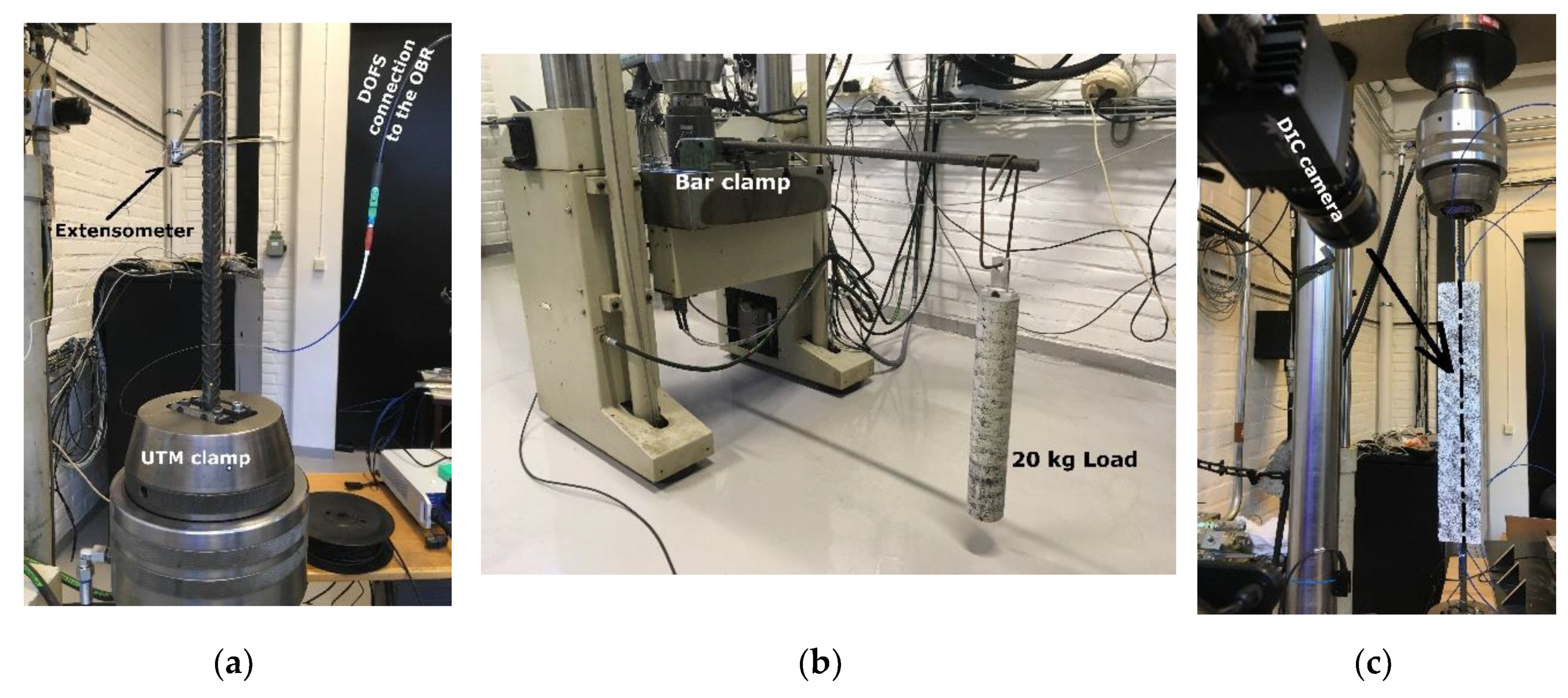
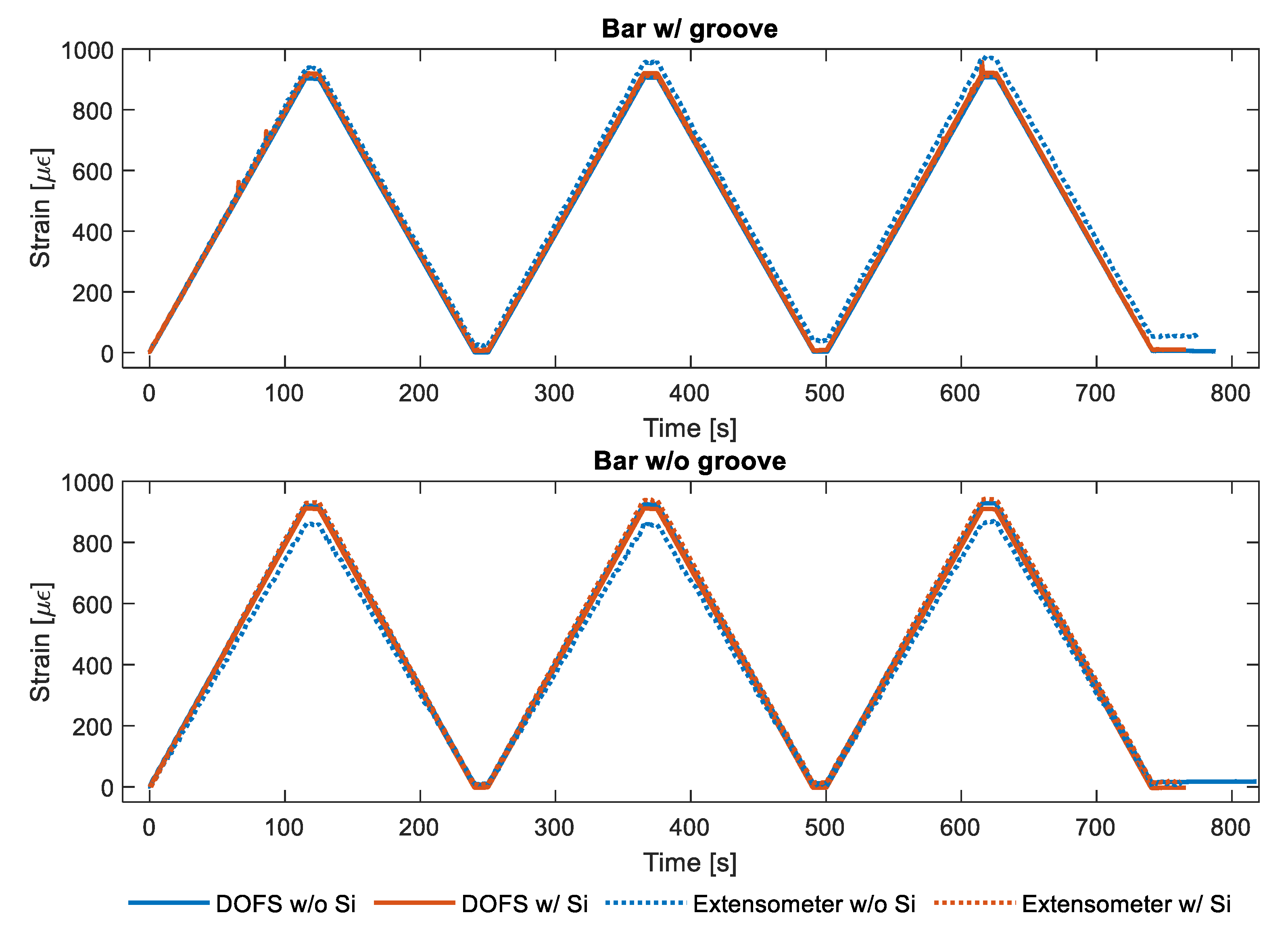
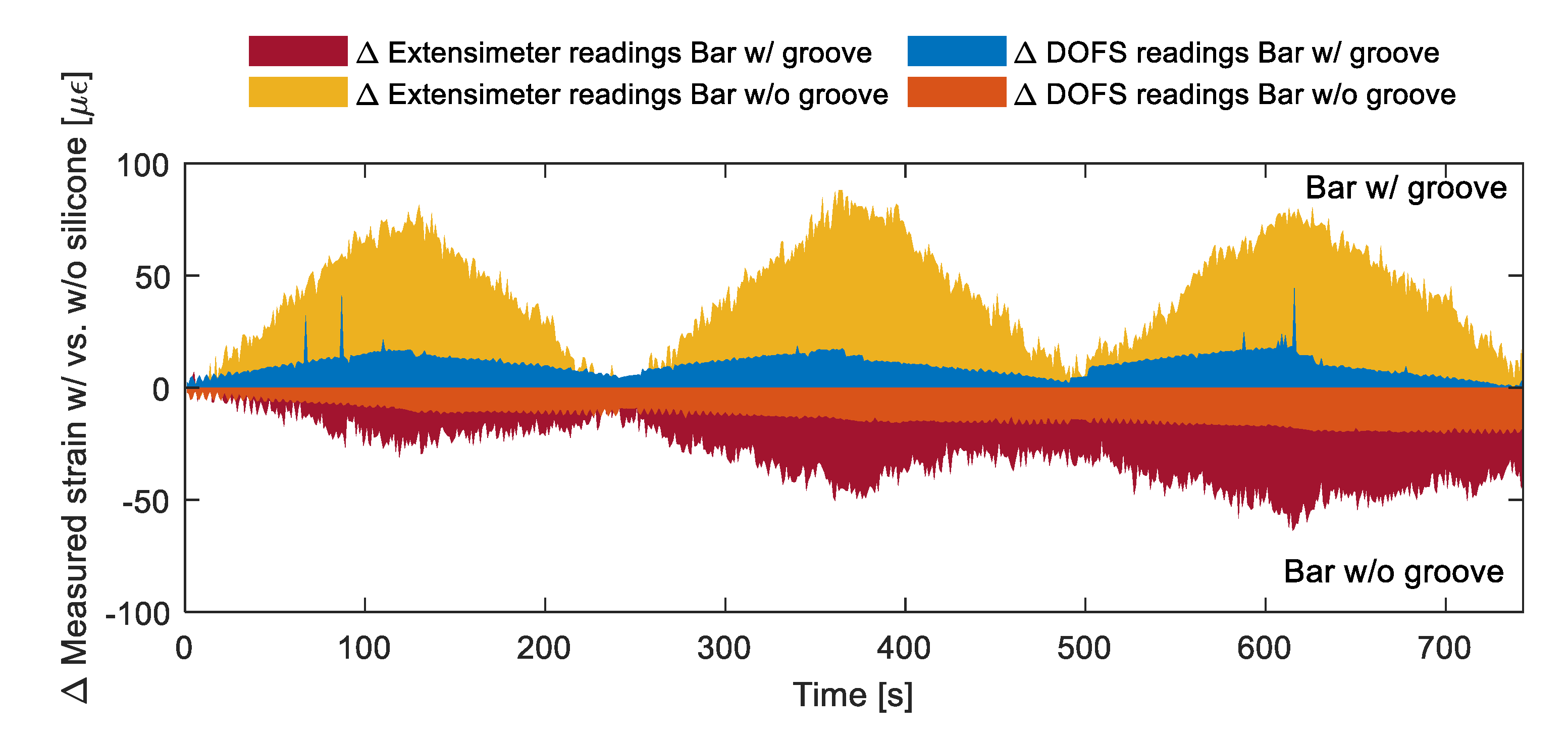
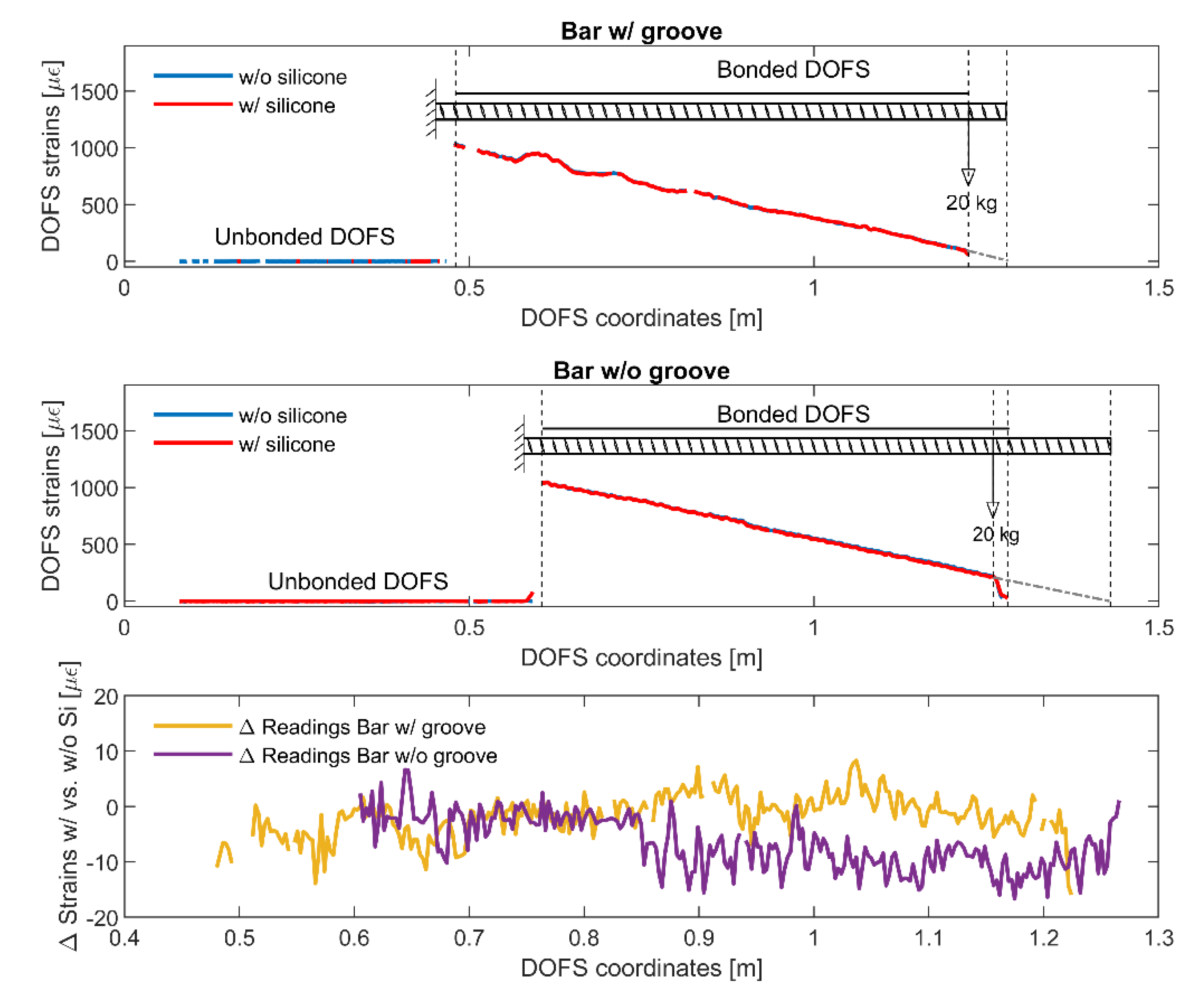
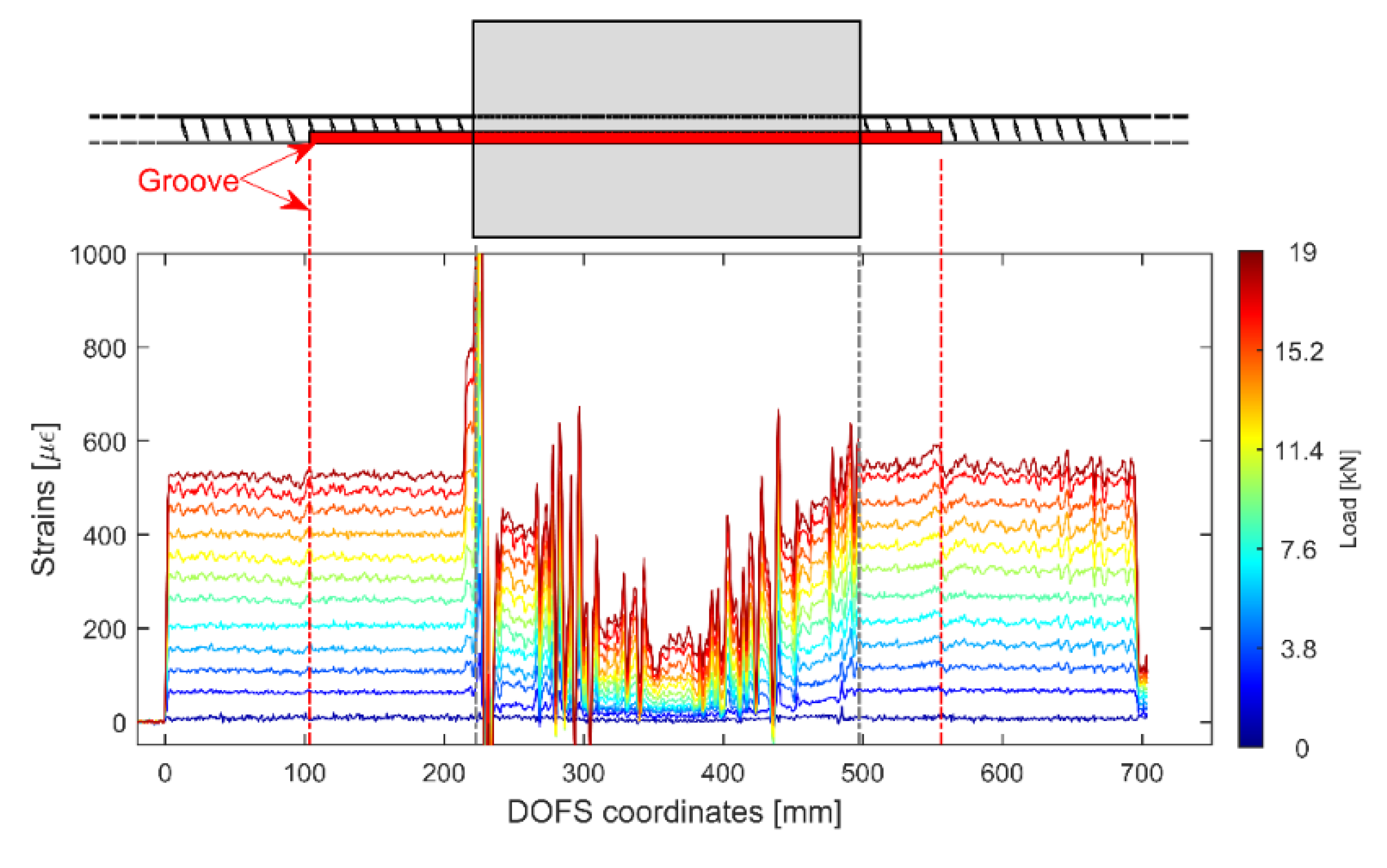
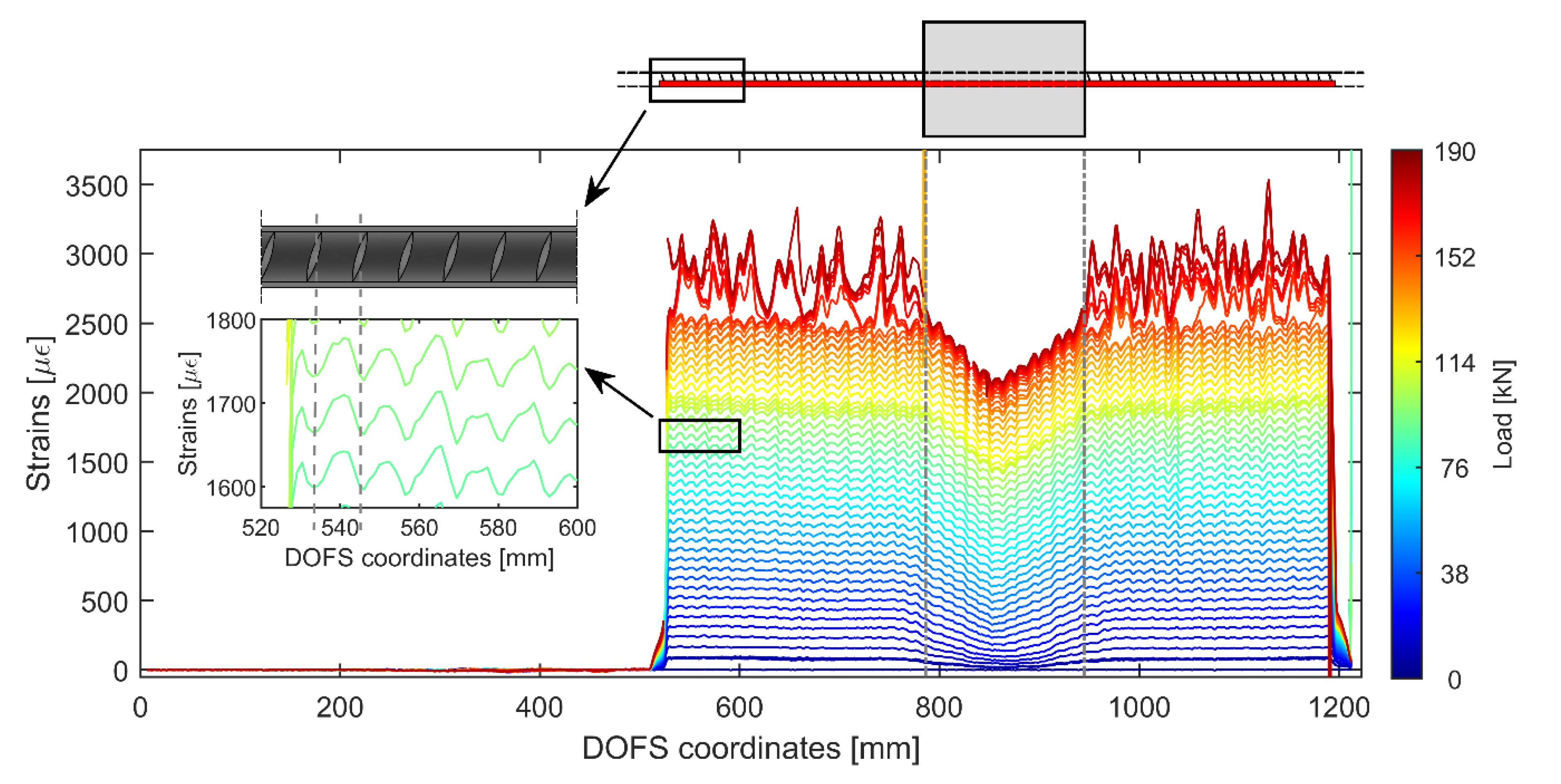
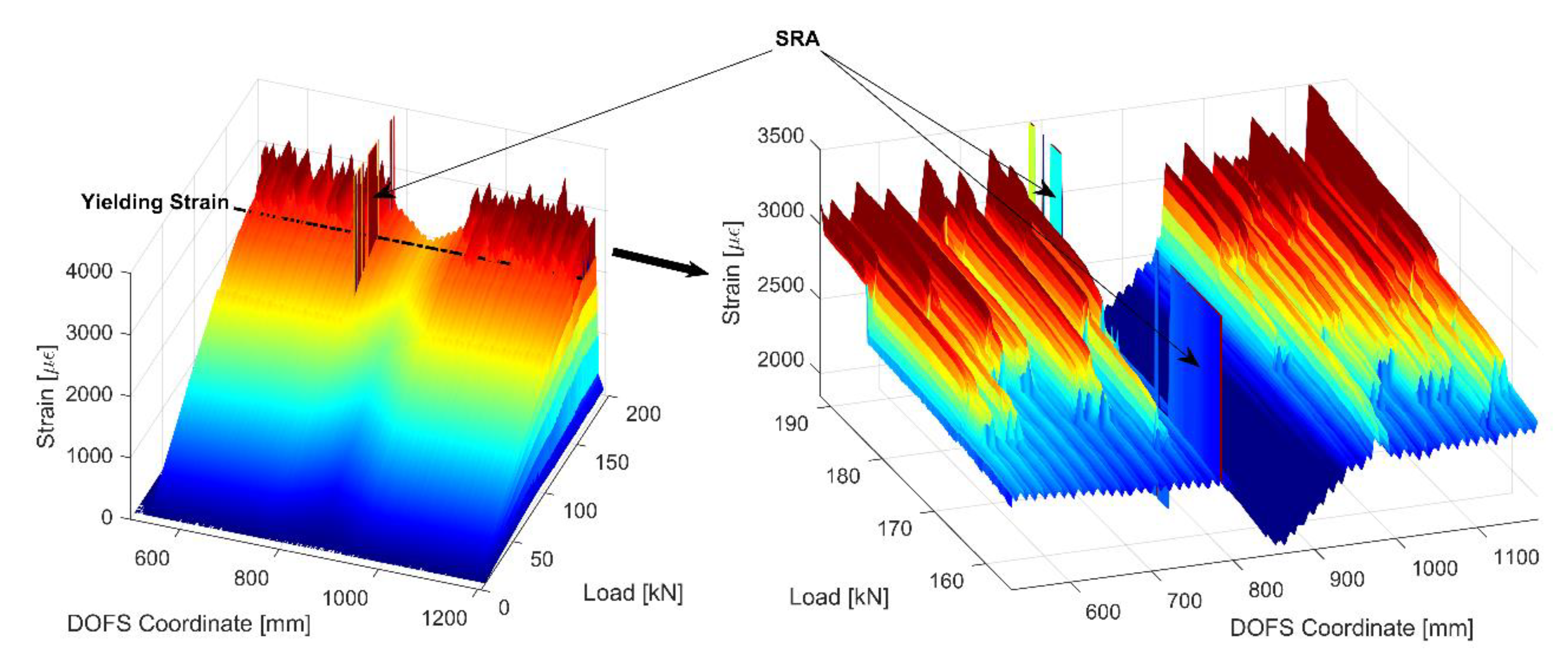
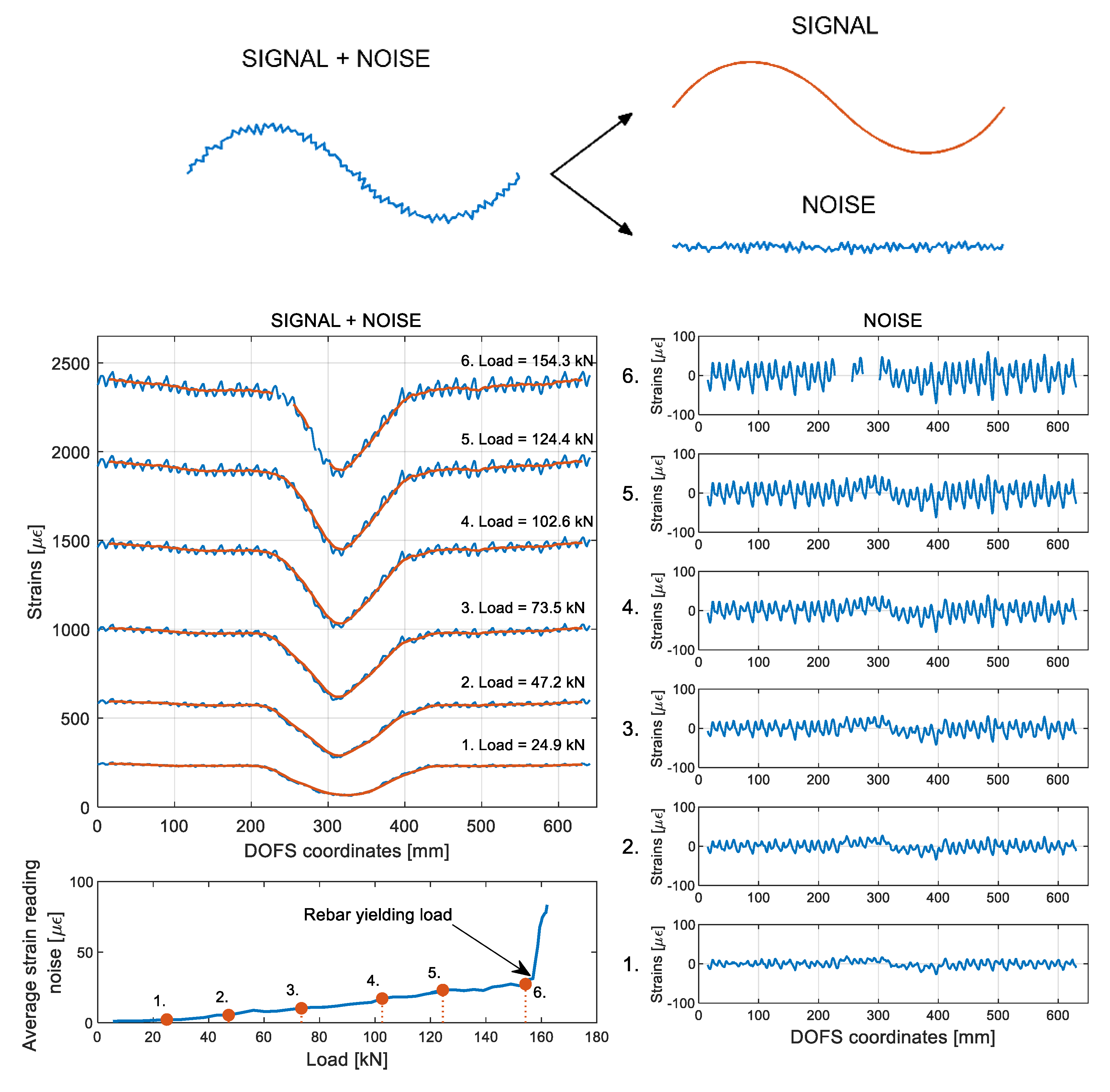
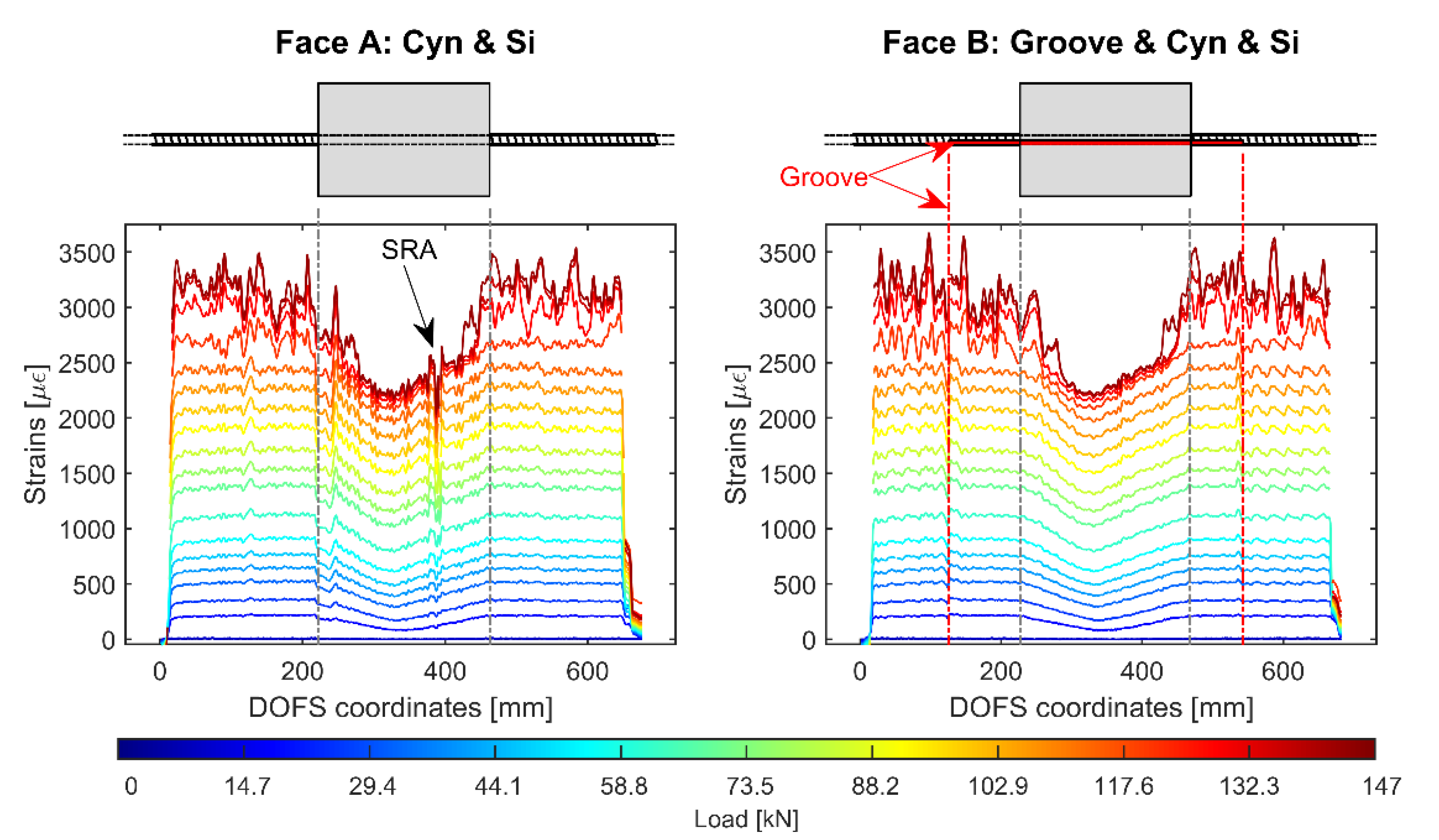
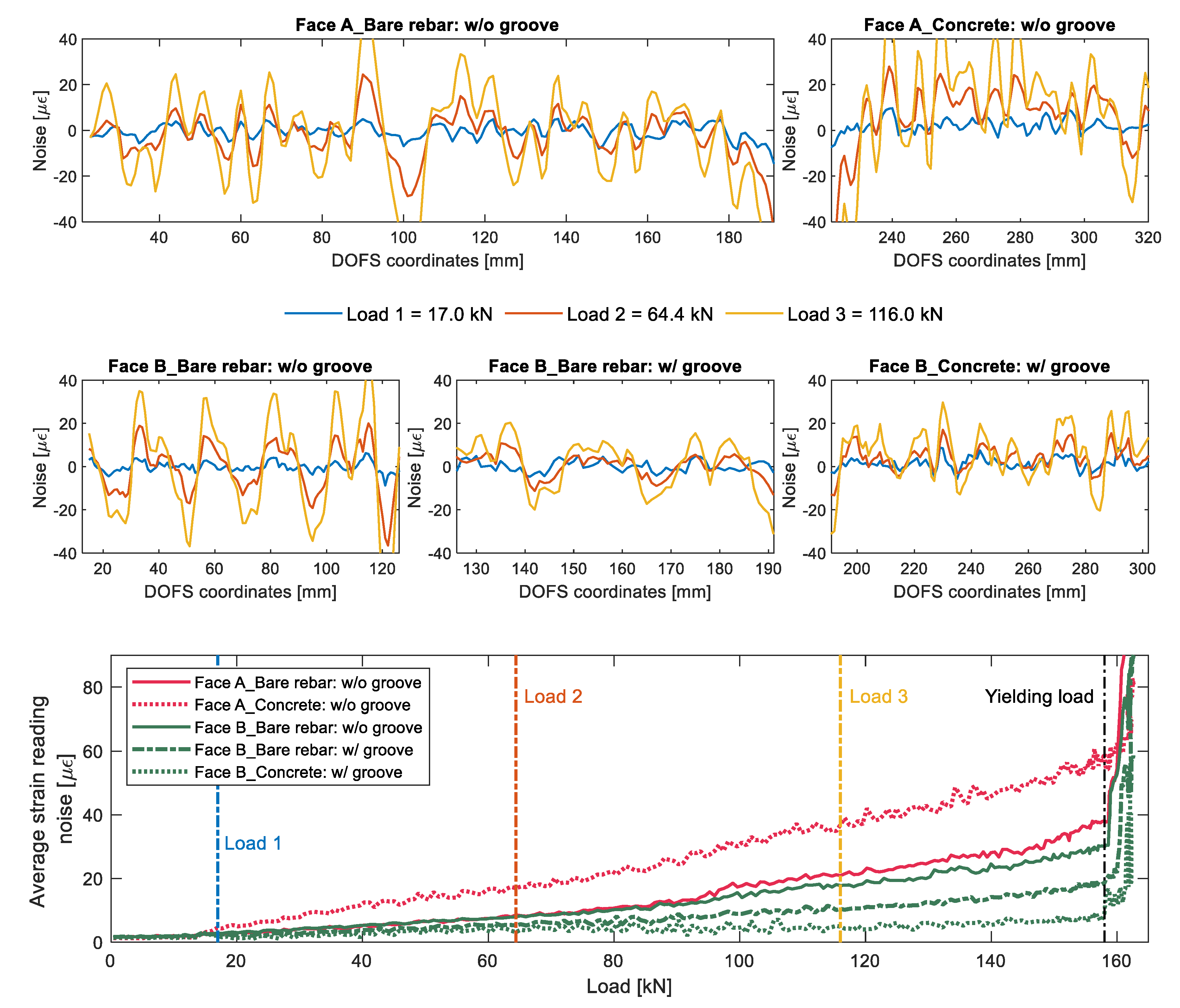
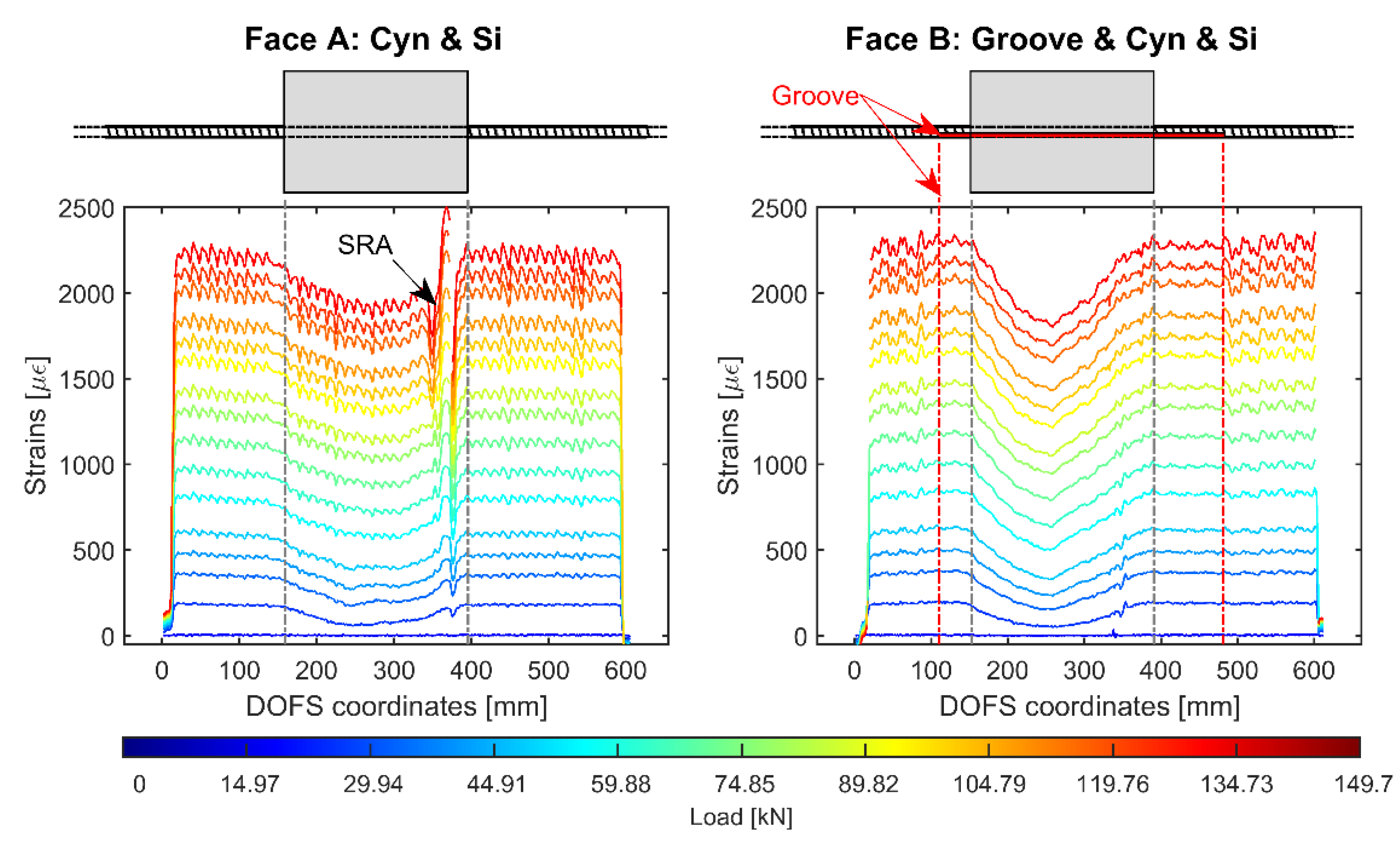
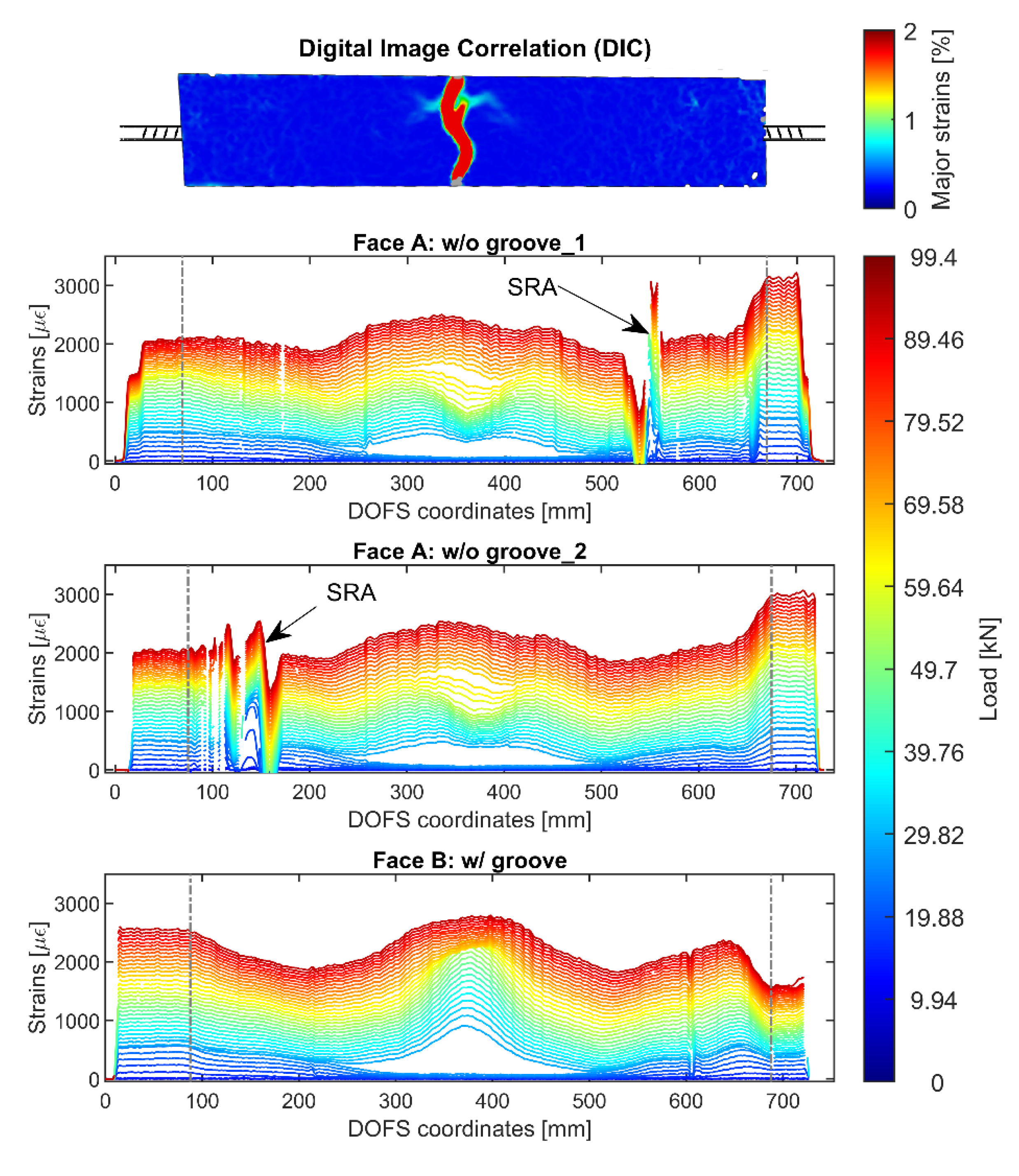
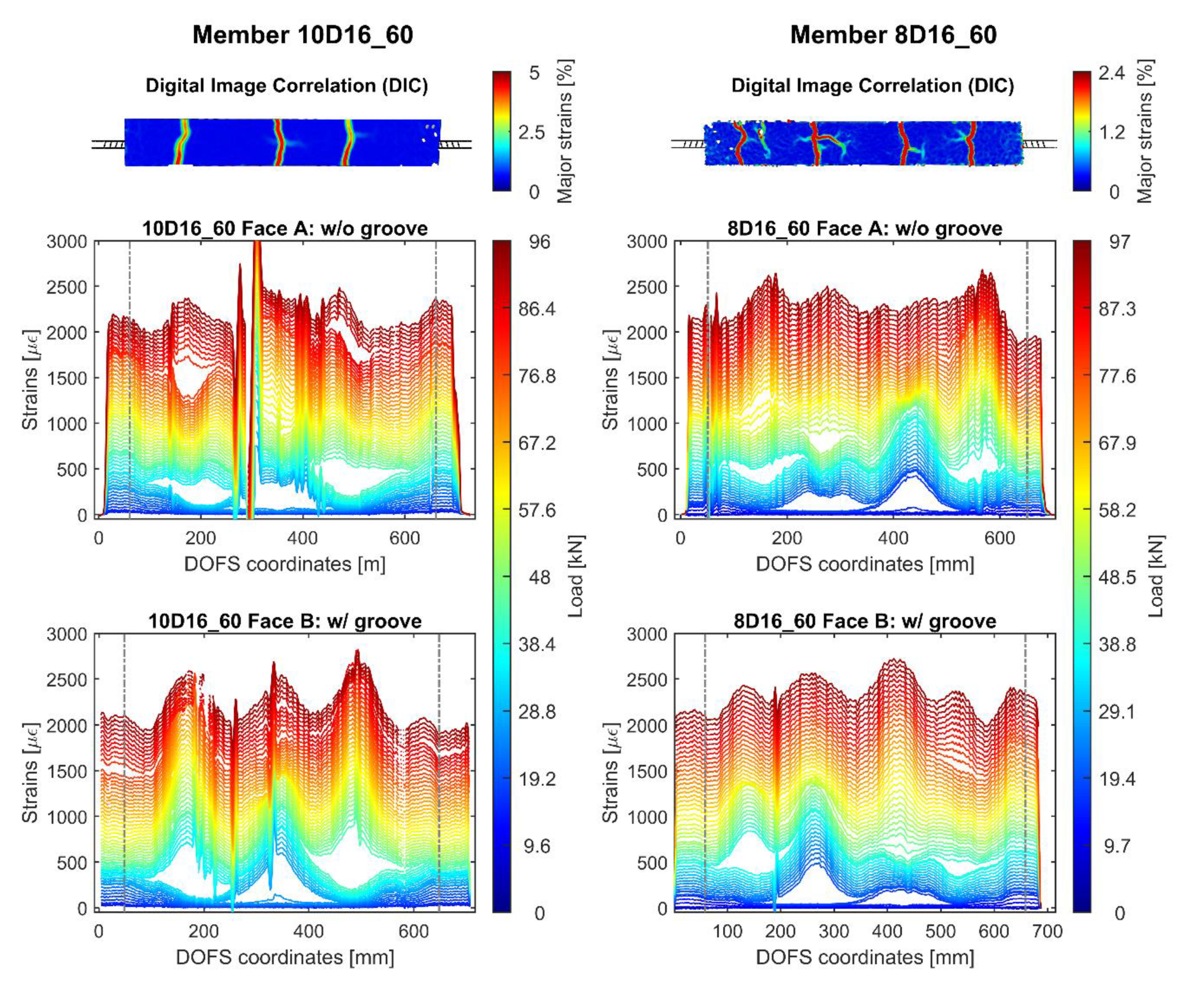
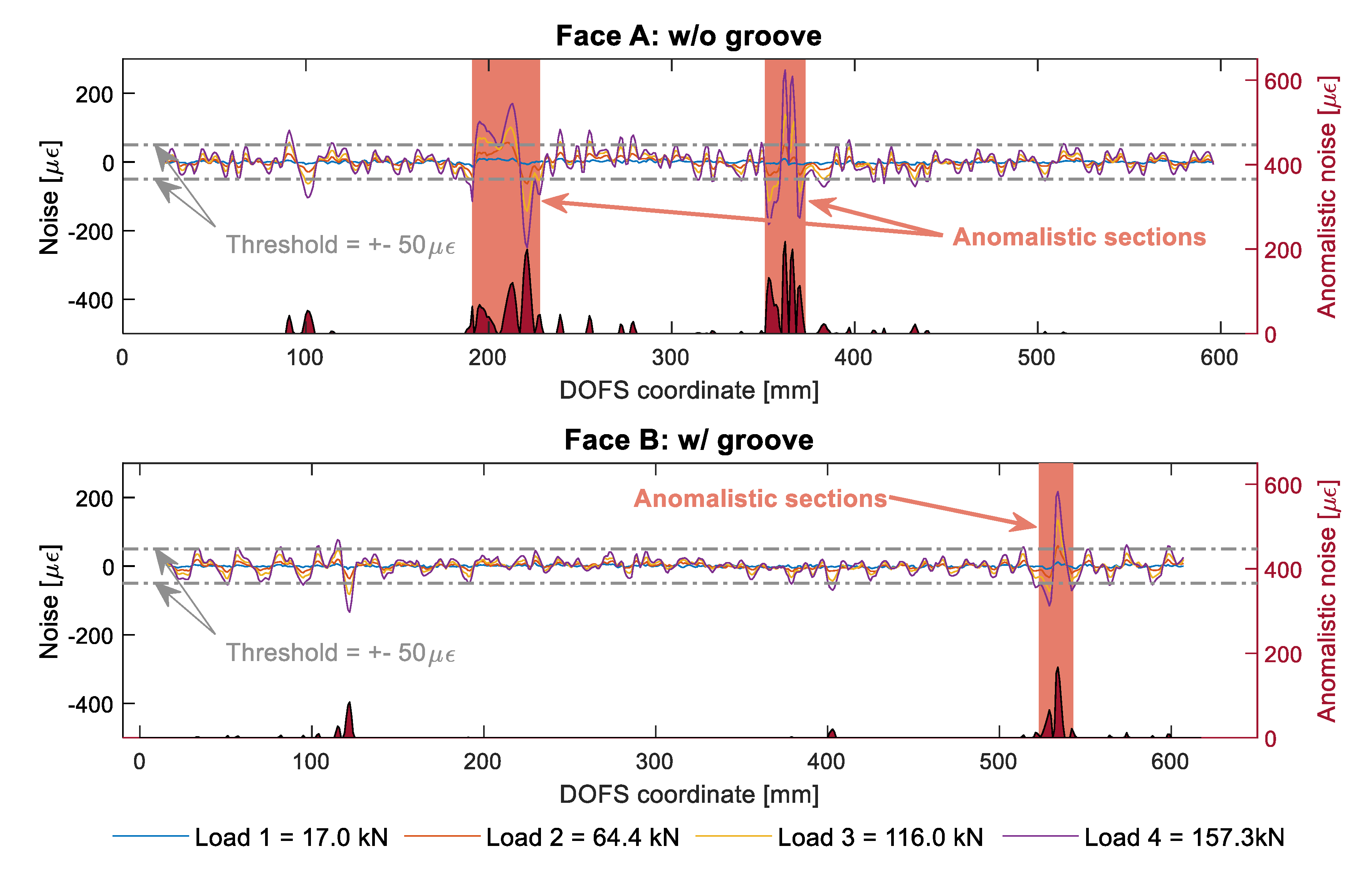
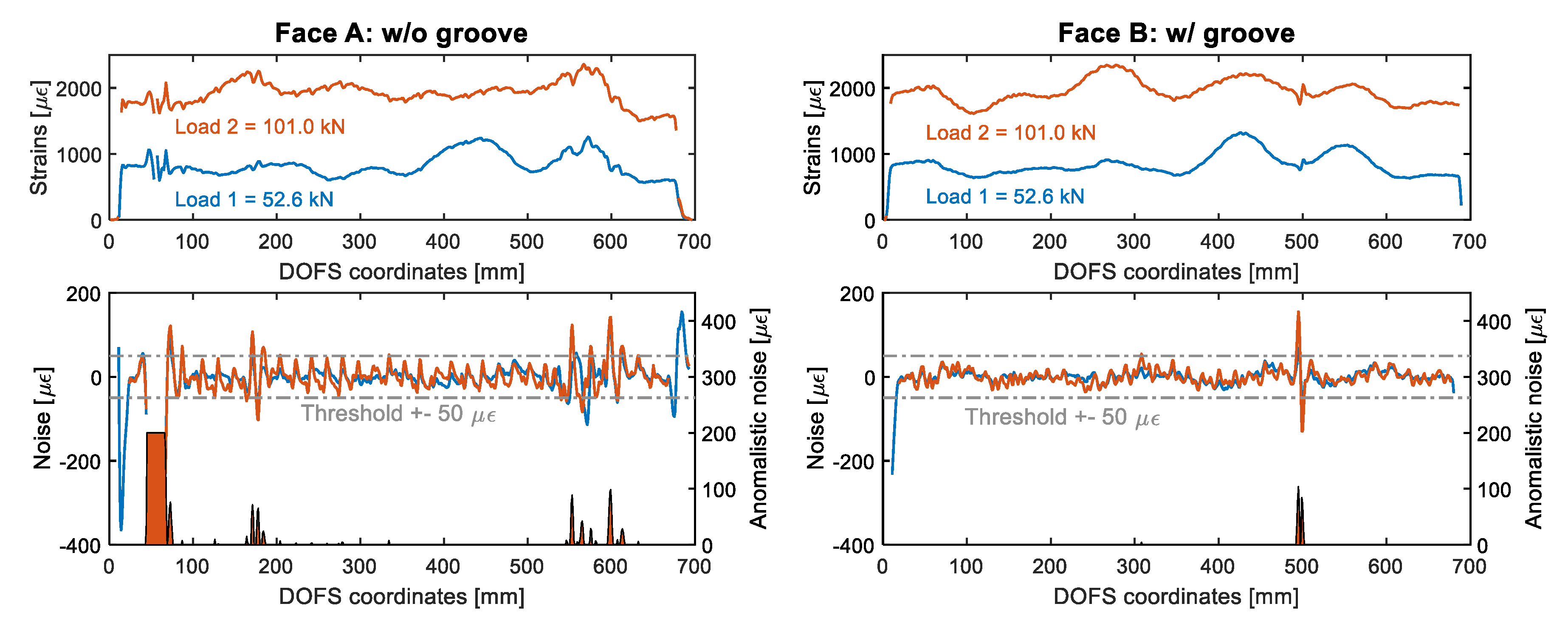
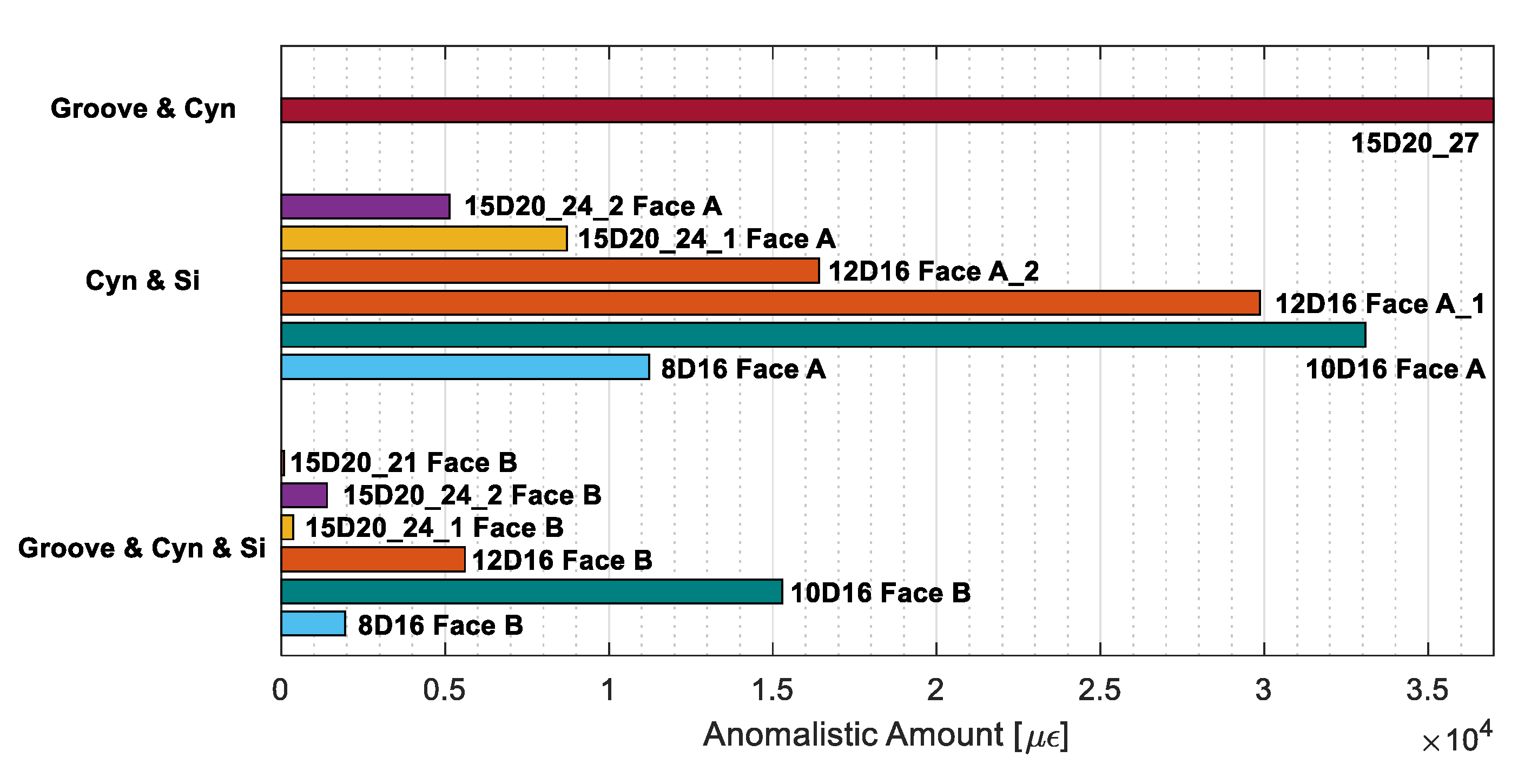
| Groove and CYN | CYN and SI | Groove and CYN and SI | ||||
|---|---|---|---|---|---|---|
| Inside Concrete: | No | Yes | No | Yes | No | Yes |
| 15D20_27 | 0.2539 | ∞ | - | - | - | - |
| 15D20_21 | - | - | - | - | 0.2084 | 0.1538 |
| 15D20_24_1 | - | - | A: 0.2298 B: 0.1815 | A: 0.3636 - | - B: 0.1041 | - B: 0.0360 |
| 15D20_24_2 | - | - | A: 0.3247 B: 0.0906 | A: 0.2015 - | - B: 0.0698 | - B: 0.0531 |
© 2020 by the authors. Licensee MDPI, Basel, Switzerland. This article is an open access article distributed under the terms and conditions of the Creative Commons Attribution (CC BY) license (http://creativecommons.org/licenses/by/4.0/).
Share and Cite
Bado, M.F.; Casas, J.R.; Dey, A.; Berrocal, C.G. Distributed Optical Fiber Sensing Bonding Techniques Performance for Embedment inside Reinforced Concrete Structures. Sensors 2020, 20, 5788. https://doi.org/10.3390/s20205788
Bado MF, Casas JR, Dey A, Berrocal CG. Distributed Optical Fiber Sensing Bonding Techniques Performance for Embedment inside Reinforced Concrete Structures. Sensors. 2020; 20(20):5788. https://doi.org/10.3390/s20205788
Chicago/Turabian StyleBado, Mattia Francesco, Joan R. Casas, Alinda Dey, and Carlos Gil Berrocal. 2020. "Distributed Optical Fiber Sensing Bonding Techniques Performance for Embedment inside Reinforced Concrete Structures" Sensors 20, no. 20: 5788. https://doi.org/10.3390/s20205788
APA StyleBado, M. F., Casas, J. R., Dey, A., & Berrocal, C. G. (2020). Distributed Optical Fiber Sensing Bonding Techniques Performance for Embedment inside Reinforced Concrete Structures. Sensors, 20(20), 5788. https://doi.org/10.3390/s20205788





